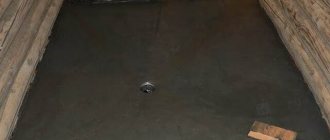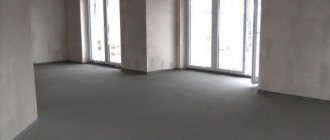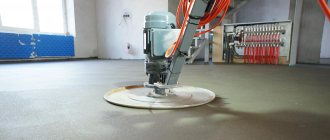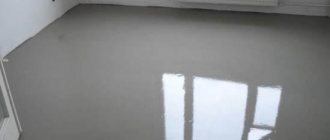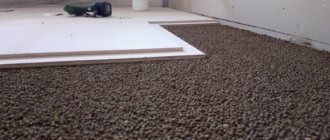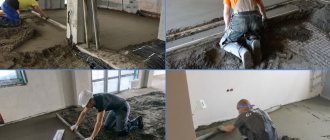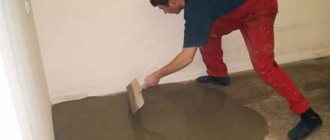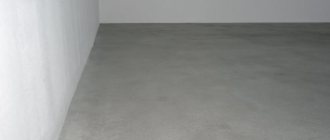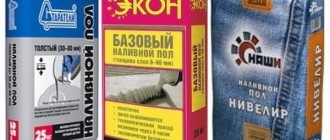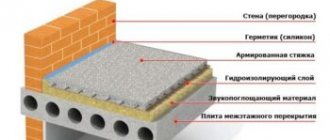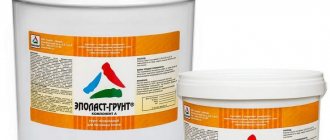Home / Gardening
Back
Published: 03/19/2020
Reading time: 13 min
0
5
- 1 How to properly fill a heated floor - screed options, types of mixtures for pouring
- 2 Preparatory steps
- 3 How to choose screening for specific brands of concrete
- 4 Self-leveling mortars
- 5 Alternatives to screening in concrete
- 6 How thick should the screed be?
- 7 Caring for wet screed
- 8 Dropout quantity and quality of concrete
How to properly fill a heated floor - screed options, types of mixtures for pouring
Screenings can be added to concrete as a fine filler instead of sand. Its task is to evenly distribute the load after the solution hardens and ensure the volume of the finished product. After all, the screening fills the gaps between the grains of crushed stone and improves the adhesion between different components.
The following advantages of screening in the use of concrete can be identified:
- Unlike sand, screenings contain more particles of different sizes: some are less than a millimeter in diameter, others can approach 10 mm (in the 0-10 fraction). Thanks to this, they better fill voids in the concrete mixture.
- Small particles (with a diameter less than 0.16 mm) are capable of reacting with cement. As a result, insoluble calcium hydrosilicates are formed, which increase the strength of concrete.
- The edges of the screening grains are not rounded, which ensures their good adhesion to cement.
- Based on screenings, it is possible to make heavier concrete, since the weight of a unit volume of material is greater than that of sand.
- If you partially replace crushed stone with screenings, you will get concrete of higher density and strength. At the same time, you can save on cement without increasing its amount in concrete.
From the information above we can conclude that screening is well suited for concrete. In many respects it is even superior to sand. In addition, in the Sverdlovsk region its cost is lower than sand. This is due to the fact that there are practically no sand quarries in our region. Therefore, sand costs almost twice as much as screenings. For this reason, even concrete plants in the vicinity of Yekaterinburg are working on screenings.
The strength of concrete largely depends on the ratio of its components. The classic solution includes cement, crushed stone and sand. Screenings can completely replace both sand and crushed stone. Fine-grained varieties of concrete are often made from screenings and cement only.
In order to find out the required weight of each component to prepare 1 cube of concrete, you need to multiply the mass fraction by the weight of the cement. Let's explain with a specific example.
Let's assume that you need to prepare a concrete solution M150.
Here is the amount of materials you need to take for this:
- Cement – 135 kg
- Crushed stone – 135×4.6=621 kg (where 135 is the weight of cement, and 4.6 is the mass fraction of crushed stone)
- Sand – 135×2.6=351 kg
- Elimination – 135×2=270 kg
Water should be added to the resulting mass (20% by weight of dry ingredients).
Thus, we have a mixture weighing 1377 kg. You need to add 275.4 liters of water to it (1377x20:100).
To find out the amount of screenings (in kg), you need to multiply the weight of cement by its mass fraction given in the table.
For example, to prepare a cube of M200 concrete you will need 286 kg of cement and 1887.6 kg of screenings (286 × 6.6).
You also need to add 15-20% water from the total amount of dry ingredients to the mixture.
So, when making a cube of M200 concrete, you use 2173.6 kg of dry mixture (286 1887.6). Therefore, you will need 434.72 liters of water (2173.6x20:100).
Next we will tell you what other fillers can be used in concrete mortar instead of screenings.
In articles that describe the installation of warm water floors, little attention is paid to such a moment as the installation of a concrete screed. But this is a very important stage where you cannot make mistakes.
In order for the mixture for a warm water floor to turn out to be of high quality, it is important not only to know the quality characteristics of the components, but also the mixing technology, what the thickness of the concrete layer should be, and at what stage of floor construction it should be poured.
The basis of the building mixture for the screed is cement. It is recommended to add plasticizers to facilitate installation and leveling of the surface. The use of plasticizers increases the density and strength of concrete, leaving virtually no small voids or cracks. If you add gypsum to the solution “to speed up the process,” the quality of the screed will deteriorate significantly, so this should not be done.
The screed is made from cement-sand mortar, screening or self-leveling is used.
How to properly fill the floor under heated floors with a water circuit? The most common type of screed is made of cement and sand. It is easy to work with; sand particles act as an excellent plasticizer.
Typically, for concrete work in living rooms, cement-sand mortars of grade 150 are used. For installing a water floor, it is recommended to use M200. With increased loads on the floors, you can use a higher brand:
- M200-M250 when installing floors in retail premises or public buildings;
- M300 is used in warehouses and garages.
Factory mixtures, which will be delivered to the repair site, are purchased at mortar units. In stores they are packaged in bags. You can make the mixture yourself. This is a more labor-intensive way, but economical. You need to maintain the dosage of the components and find river sand with a coarse fraction.
Cement-sand mixtures for damp, wet rooms (bathrooms, swimming pools) are made with M400 cement. M500 cement quickly gains strength and is suitable for rooms with dry floors. The recommended thickness of underfloor heating screed is about 40 mm. In this case, laying a water-heated floor in a screed will be carried out without difficulty.
How to properly fill a warm water floor so that it lasts a long time? It must be resistant not only to mechanical, but also to thermal stress. It is recommended to add polypropylene fiber to the solutions: 900 grams per 1 cubic meter. The cost of such an additive is small, but it will increase the level of strength of the screed and prevent the appearance of small cracks. You should be aware that the fiber additive does not replace the reinforcing mesh.
The construction of a cement-sand screed of a concrete layer from screenings can be done in two ways: “wet” and “semi-dry”. There is no difference between the proportions using sand or screenings. The only difference is the amount of water that is added to obtain a certain consistency.
If a lot of water is added to the solution, you get a “wet” screed. The solution will be plastic.
The component ratios are as follows:
- When laying heated floors in a dry living space, an M200 solution using M500 cement is suitable. You will need 1 part cement, 3 parts sand and 1-1.4 parts water.
- When laying heated floors in a damp room (in a bathroom), you need an M200 solution based on M400 cement. Take 1 part cement, 2.5 parts sand and 1-1.4 parts water.
- In reality, the volume of liquid depends on the moisture level of the sand and the amount of dust in it. In this regard, water is added gradually, mixed and plasticity is controlled. The result should be a mixture similar to thick sour cream.
- The solution is leveled between the pipes and compacted, removing air bubbles.
On a note. Metal-plastic pipes can become deformed if you walk on them. Polyethylene is more durable in this regard.
The process of leveling the mixture is facilitated by a long rule and pre-placed beacons. The recesses are filled with the mixture and leveled again.
The screed is made from the screenings in the same way. But everything is done more carefully, more labor will be required. The advantage of the “wet” method is the plasticity of the solution, which is easy to level with a rule.
We suggest you familiarize yourself with Red Prussian cockroaches in an apartment: how to get rid of them?
There is much less water in the solution for the “semi-dry” method. If the mixture is made correctly, it will be moist but not runny.
They check it this way: squeeze a little semi-dry solution in your palm. It should form into a plastic lump without cracks. This is the consistency of a factory-made solution. It is more difficult to level, but then you can rub it to a shine, and ultimately get a surface that is dense and durable in structure.
If you order such a solution ready-made, you need to explain for what purposes it will be used. This concrete layer can withstand heavy loads. It is of higher quality than when laying concrete using the “wet” method.
You will have to grout very carefully; this requires skill and patience. You will need a long trowel or trowel. Semi-dry mixtures from screenings are practically not amenable to smooth grouting, so it is ground with sandy mortar.
In order for the concrete layer to be perfectly smooth, you need to position the beacons correctly. The distance between the beacons is left such that the one and a half meter rule can be used. That is, a distance of no more than 140 cm should be maintained between the beacons.
- Mortar beacons made of narrow ridges of cement-sand mortar (gypsum cannot be used). Not the most effective method, since the ridges must dry out, and this takes time. In addition, a rule can accidentally “knock down” such pointers.
- Lighthouses made of metal pipes. Pipes or other rigid profiles are strengthened at the required height. A day after laying the concrete, they are removed and the recesses are filled with mortar. Pipes are used several times for this purpose. The only condition is that they must be perfectly even. Both round and rectangular profiles are used.
- Galvanized guides for plaster. The stronger the beacons, the better. The optimal size is 1-1.4 cm. After they have performed their function, they can be left in place or removed after the solution has set. Such beacons are disposable. If you have the skills, you can set them as evenly as possible. Strengthen with mortar, adjusting it to the level using a piece of tile or a brick fragment. The distance between the beacons is 40-50 cm. Sometimes they are installed on special supports that can be adjusted.
When building your own house, cottage or garage, one of the main criteria for many developers is price - an issue that is most often resolved by searching for and using cheap materials.
One option is to use waste concrete that is economical and has sufficient mechanical characteristics.
As in the case of the use of standard types of filler, the technical characteristics of a concrete mix with screenings are provided mainly by the binder material. To prepare concrete with screenings, only high-grade cement is used as a binder - M400 and M500, which ensures a high degree of adhesion to the surface of the filler grains.
Regardless of the purpose and responsibility of the concrete structure, you should not use expired cement or mix it with new one. After the warranty period expires or if storage conditions are violated, cement, as a result of its hygroscopicity, becomes saturated with moisture, clumps and loses its strength characteristics.
A common mistake among non-professionals is to increase the proportion of cement in the mortar to increase the strength properties of concrete, which leads to the opposite result. Excess cement disrupts the structure of the material and reduces the mechanical bonds between filler grains, increasing the fragility of the finished product.
Mixing the solution.
The need for screed in an apartment
For some, the need to install a screed in an apartment is not obvious. However, even in such a room it is highly recommended to lay this layer. One of the reasons is that the screed can provide good sound insulation of the apartment. If there is no screed or it is of poor quality or thin, then the neighbors below will perfectly hear the stomping of children and loud conversations, and this is unpleasant and wrong for other residents of apartment buildings. Therefore, the better the soundproofing properties, the more pleasant it is to live in such a house.
Preparation of mortar for floor screed
Sources of noise in city apartments
Noise is divided into two categories - shock and airborne. The latter includes all everyday, “home” sounds. This is the speech of people, the sound of a working radio and TV, the growling of a dog, etc. To prevent all these sounds from spreading outside the apartment, thick-walled partitions and massive elements are used in the construction of houses.
And the thicker the walls and floors, the less likely it is that this noise will be heard by anyone other than those in the apartment. The shock type of noise includes the movement of objects on the floor, jumping, and loud steps. These sounds usually travel through ceilings. It is quite difficult to make sure that none of this is heard outside the home. However, the level of such noise is well reduced by a floating screed.
Cement-sand floor screed
You will also have to install a screed in an apartment if it was laid poorly during the construction of the house. Pieces of reinforcement may stick out from it or the floor slabs, the surface may be skewed, and if the apartment is located on the ground floor, then in the absence of a screed, the floor will be very cold.
To level the floor slabs, use a tie screed. In apartments, interfloor ceilings are usually made of reinforced concrete slabs. This type of cement-sand screed is also suitable for a bathhouse on a slab foundation. But only if waterproofing and insulation are not required. That is, this type of floor leveling is suitable for vestibules, porches, and verandas.
Different types of ties are used for different occasions and spaces. This is reinforced with a metal mesh over a layer of expanded clay for insulation.
The main task of the preparatory work in this case is to ensure the best possible adhesion of the concrete layer to the base. To do this, it is important to thoroughly remove all debris and dust. It is better to do this with a vacuum cleaner - a broom cannot remove all the dust. There is no need to level out uneven areas; on the contrary, if there are smooth areas, you need to make grooves or holes in them. You can only fill deep cracks, and not even the surface.
After removing debris and dust, the surface is generously coated with primer. It can be poured onto the floor and then spread with a large brush or roller. It can take up to 7-8 hours for the primer to dry, depending on humidity and air temperature. After drying, you can begin placing the beacons and laying the solution.
We invite you to familiarize yourself with Foundation screed with reinforcement. Do-it-yourself reinforcement: concrete floor screeds, floor slabs, foundations
When laying a floating floor, it is important not to forget about the damper tape
In order to prevent the destruction of the screed or walls due to different amounts of expansion during temperature changes, a damper tape is rolled out around the perimeter of the room. This is especially important if the walls are made of wood, which is almost the rule in bathhouses. The tape rolls out and sticks to the walls. It usually exceeds the height of the screed, but after the cement has set, it is cut flush with the floor.
If waterproofing is necessary, the cement-sand screed will no longer be cohesive. Here the approach to preparing the foundation is different. The waterproofing is rolled out onto a cleaned and flat surface. If the base is uneven, for example, the surface of a slab foundation in a bathhouse, then it is first leveled. To do this, use the tie tie described above. After it has matured, the waterproofing is rolled out and another layer of concrete is poured (damper tape is also necessary).
In the presence of waterproofing, the screed becomes incoherent
Due to the fact that the base with such a device does not absorb moisture, there is a high probability of the formation of cavities and pores. Therefore, processing the solution with a vibrator is necessary here. By increasing the thickness of the floor screed to 10 cm, the problem solves itself, but the costs and weight are significant.
Preparatory actions
Sometimes, when preparing the surface for screed, people do not pay attention to important details that, in fact, play a big role. The rough surface must be thoroughly cleaned of debris and small stones.
Before properly pouring the heated floor, a damper tape with a thickness of at least 40 mm is laid along the walls of the room in a circle. It is needed in order to prevent future cracks in the concrete layer from the effect of thermal expansion. The damper tape should not be neglected under any circumstances. Cracks in concrete will damage the heating system very quickly. It is necessary to make a heated floor cake on concrete according to all standards.
When the room area is more than 40 square meters. meters, or one of the sides is more than 8-9 meters, the concrete coating must be divided into zones using thermal joints. To do this, use a T-shaped damper tape. It is laid before concrete work begins. Each zone must have its own heating circuit; this should be designed in advance.
Sometimes craftsmen lay reinforcing metal mesh on top of the insulating board. If the heat insulator is durable and the load on the heated floors is not very large, such a mesh can be ignored. The mesh is attached to the concrete through a layer of insulation. The water circuit is twisted with mesh rods. This method is convenient, but not justified in all cases.
When using durable insulation (foam glass), the situation will be different. If soft insulation (foam plastic) is used, the screed must be additionally reinforced. Reinforcement, which is placed on top, and not in the concrete itself, neutralizes only horizontal deflections. To prevent the formation of splits, the mesh is placed closer to the center of the concrete covering, above the pipes.
Sometimes they use an option where two meshes are laid: on top of the pipes and under them.
There is another way using one grid. It is raised above the heat insulator by 15-20 mm using pads. The pipes are laid on top.
A screed where the water circuit is completely embedded in concrete will be stronger. But the cost of constructing a heated floor is increasing. The total thickness of the concrete layer will be 20-30 mm greater.
On a note. Before starting concrete work, water should be poured into the circuit, creating working pressure in the pipes. Sometimes they use compressed air. It is prohibited to heat the pipes.
How to choose screening for specific brands of concrete
To get high-quality concrete from screenings, you need to choose the right material. Not all varieties are suitable for this purpose. To purchase a quality product, you need to study several of its characteristics.
Here's what we recommend paying special attention to:
- Type of rock It is best to choose material from durable igneous rocks (granite, basalt). When crushing them, less dust is formed, so the screening is cleaner and of higher quality, without small particles. In addition, it is highly durable and can partially replace crushed stone. Depending on the acidity of the rock, the screenings also differ in their hydrophilicity. Acidic granite absorbs water well. This ensures a dense and durable structure of concrete products. Alkaline varieties (diabase, limestone), on the contrary, repel moisture. Therefore, it is recommended to add plasticizers to them.
- Fraction There are 2 screening fractions on sale – 0-5 and 0-10. Both are suitable for making concrete. But if you need to level the surface or make a thin screed, we recommend a selection of 0-5. Fraction 0-10 can partially replace fine crushed stone. It also fills the spaces between large stones well and creates a strong frame.
- Strength The higher the crushability grade (or strength) of the rock, the more reliable the concrete will be. In addition, durable materials produce less dust when crushed.
- Grain composition It is desirable that the screenings contain more particles with sizes of 1.5-4 mm. They are best suited for concrete mix. Dust and clay impurities should not exceed 3-10%. Otherwise, more water will be needed to make the solution, adhesion will deteriorate, and the final product will be less durable.
- Class It is determined mainly by purity and the content of dust and clay particles. There are 2 dropout classes. For concrete, it is better to take the material of the first group. Its quality must be confirmed by appropriate certificates. The content of dust and clay particles in it should not exceed more than 3%. The second class (up to 10% dust and clay) is suitable only for concrete used in private construction: for fences, outbuildings, pouring courtyards, garden paths.
- Radioactivity This indicator is important for determining the safety of screening. For construction in a residential area, the radioactivity of any materials should not exceed 370 Bq/kg.
In the next part of the article we will provide information on which screening is suitable for different brands of concrete.
The grade of concrete is determined by its average strength. Tests are carried out 28 days after making the solution, when it has completely hardened. The indicator is designated by the letter M and a number (from 50 to 600), determined in the laboratory. For example, M75 concrete can withstand a load of 75 kg/cm2 and does not collapse, and M500 - 500 kg/cm2.
We invite you to familiarize yourself with Cracks in logs (beams) of a log house: methods of preventing and repairing wood defects
The higher the grade of concrete, the more expensive it costs. This is due to the fact that more high-quality cement is added to it. Therefore, the brand should be chosen based on your needs. You should not overpay if you need concrete for pouring fence posts or platforms. At the same time, when building the foundation of a house, savings may result in some problems in the future (walls on an unstable foundation will sag and cracks will appear on them).
Below in the table we have indicated which types of screenings are best used for the production of concrete of different grades.
How to read the table:
- “-” – the material is not suitable for concrete
- “ ” – the material can be used, but there are better options
- “ ” – the material is well suited for the manufacture of this brand of concrete
The table above shows which materials you should pay attention to when choosing. But it is not the ultimate truth. It is summary and only helps to get a general idea. It also takes into account not only the quality of the screening, but also its cost. After all, the lower the grade of concrete you need, the more rational it is to save on its production.
As can be seen from the table data, screenings from diorite, gabbro and marble from our region are not suitable for the manufacture of concrete. This is due to some properties of these materials. Diorite screenings have large grains, more like crushed stone. It is durable, but quite expensive. Therefore, it is not beneficial to use it for solutions.
The gabbro screenings in our area contain many dust particles. The surface of grains from this rock is smooth and has poor adhesion to the components of the solution. Marble chips have lower strength and frost resistance, and they also contain a lot of dust.
Sometimes it is recommended to use concrete screenings as a filler. This is a recycled material, and its quality largely depends on the performance of the concrete from which it was obtained. Its characteristics do not always meet the requirements. Such screening can only be used for low grades intended for non-critical work (filling fence posts, garden paths, floors in utility rooms).
Screenings from different quarries may also differ in both class and strength. Therefore, it is always worth checking the indicators with the supplier. In our region, for example, gabbro material is not of high quality, so it is not used for concrete. But in other areas, gabbro screenings may well be used to fill the concrete mixture.
Here are some examples of using screenings for different types of concrete:
- Do you need to fill the base of fence posts with M100 or M150 concrete? For such work there is no point in using expensive granite or serpentinite. Limestone with a strength of M600 and above and a low content of dust and clay particles is quite suitable for you.
- Are you building a two-story house and need M350 concrete for this? For it you can take granite or serpentinite. At the same time, granite has a better price-quality ratio, so we recommend this material.
There is also one important feature - the formation of the price of the material. It is necessary to take into account that the farther from your site the quarry producing screening is located, the more expensive the material from it will be. Therefore, it may turn out that an expensive granite screening will cost you less than a limestone one (for example, if you live next to a granite quarry, and the limestone one is located far away). Our managers will be able to advise you in more detail on this issue when ordering.
You will learn more about concrete for different jobs and the choice of screenings for them in the next part of the text.
Concrete is used for various purposes. Foundations under houses and fences, floors, and screeds are made from it. The solution is used to fill courtyards, road bases and pedestrian areas. For each type of work, depending on the complexity, they use their own brand.
In the table below we have provided information on what type of screening is best to take for specific construction purposes.
To better understand the data from the table, here are specific examples:
- Concrete for fence posts should not be very strong. There is no point in spending expensive granite screenings on it if you can get by with more affordable limestone ones.
- When screeding or pouring a floor, it is important that the surface is as flat as possible. Therefore, in such cases it is recommended to take fraction 0-5. As for strength, any variety is also suitable here. Much depends on what load the ceiling will bear in the future.
- When building a house of 2 floors or higher, it is necessary to build a solid foundation. Therefore, it is recommended to take granite screenings here.
- When installing concrete foundations under highways and highways, you should also pay attention to strength. Granite is well suited for such work. Serpentinite can also be used if the material is available in the region and you can save on its delivery.
As can be seen from the tables above, the most universal is granite screening of fractions 0-5 and 0-10. Other varieties can also be used to save money. But we recommend doing this only in cases where the requirements for concrete strength are low.
What can be used to create a screed?
Depending on the type of screed, they can be made of various materials. So, cement, water and sand are used to create a wet screed. In this case, cement acts as a binding material, and sand becomes a filler. To improve the quality of building mixtures, various components can be added to them to improve strength and reduce drying time.
Leveling concrete using the rule
To create a wet screed, ready-made sand concrete sold in stores can also be used. Its main disadvantage is the high shrinkage rate. Because of this, the thickness of the screed layer cannot be less than 3 cm, otherwise it will quickly become covered with cracks.
Fiber fiber for screed
For wooden floors, gypsum-based mixtures are used. This material can be laid in a thin layer, as it practically does not shrink. Drying times are also attractive - only 1-2 days. The only exception to the use of such compounds is high indoor humidity.
We suggest you read: Is it possible to clean a refrigerator with bleach? How to clean the inside of a refrigerator
Self-leveling or self-leveling floors are usually used for final leveling of conventional wet screed. The reason is the fairly high cost of the material. This composition is used to level floors with unevenness of 2-7 mm.
Gypsum self-leveling floor
To make a dry screed, you will need sheet materials such as plasterboard, as well as medium and fine expanded clay for filling the base. The joints of individual sheets of material are treated with adhesives.
Dry floor screed and installation of gypsum fiber boards
Self-leveling solutions
You can use a self-leveling mixture to screed a warm water floor.
This building material is not cheap. Labor costs are noticeably reduced. Simply add water to the dry mixture, stir, pour it onto the floor and you don’t need to do anything else. The mixture will even out on its own.
The advantage of self-levelers is the harmoniously selected components of the solution, mixed in the factory. The mixture is already enriched with the necessary additives and plasticizers.
The finished leveling solution is poured onto previously prepared floors and stretched over the beacons. If you follow the manufacturer's recommendations, you will get a durable surface that is resistant to temperature changes.
There are some subtleties here that you should be aware of before purchasing a self-leveler. It sets very quickly, and you will need a lot of solution. If you fill the floors in small bathrooms, then there will be no problems. The mixture can be stirred with a drill mixer. But how to quickly mix, at one time, a cubic meter of solution for a room of more than 20 square meters?
We invite you to familiarize yourself with what to plant in the fall at the dacha. Autumn work at the dacha in October
In order to fill large volumes, you can buy or rent such equipment. But under normal conditions, for apartment renovation, this is impractical. The self-leveler will still have to be leveled manually.
Such a solution will pay off in a “burning” facility if you have an unlimited budget. Or when laying heated floors in a small area. There are brands of self-leveling that can be laid in a thick layer. You should know: despite the fact that such a solution sets quickly, it reaches “standard” within 7-15 days, no less.
Dry screed for laminate flooring
In addition to all the above types of screed layer, there is another one - dry screed. This is a simple and quick way to level the surface under the laminate. To level the base floor, gypsum fiber board sheets, chipboard panels or plywood are used.
Using a level, the height of the future screed is measured and markings are made on the walls. Next, the base of the floor is covered with a waterproofing layer. After this, the main stage follows - installation of beacons.
Beacons are U-shaped profiles that are fixed at a distance of 0.5-0.7 m from each other. To quickly and securely fix them, you can use alabaster or plaster.
After installing such a system, you can proceed to filling the dry mixture, this can be quartz sand, expanded perlite sand, fine-grained slag or expanded clay screenings. The mixture is carefully leveled along the beacons, being slightly above their level.
Now you can lay gypsum fiber sheets, plywood or chipboard, securing them with screws, after which you can immediately begin laying the laminate.
Alternatives to screening in concrete
Various materials are used as fine filler for concrete mixtures. Screening is not even the most popular of them, because it is not available in every region.
Instead of screening, they also use:
- Sand This is the most common material used as a fine filler in concrete. It is recommended to use river sand or purified quarry sand, coarse-grained. Products made from it are lighter, but also less durable.
- Sand-gravel mixture, or PGSV, its composition includes gravel and sand in different proportions. This material is inexpensive, but not always of high quality. When purchasing, you need to carefully study the ratio of components so that when adding ASG to concrete, its strength does not suffer. The sand-gravel mixture replaces not only screenings, but also crushed stone.
- Sand-crushed stone mixture, or PSCHSP, in its structure it resembles ASG, but is obtained artificially in the process of crushing crushed stone. Often, instead of sand, it contains screenings, since factories sell waste containing large and small particles under the guise of PSH. In this case, the material will be replaced not by screenings, but by sand and crushed stone. When purchasing PSH for concrete, you need to carefully study its composition and percentage of components.
The choice of fine aggregate in a concrete mix depends on its availability and the purpose of the concrete. Among all the alternatives, screening is the most inexpensive option (specifically in the Sverdlovsk region). It can replace both sand and crushed stone at the same time. And for the production of some varieties (for example, fine-grained concrete), screenings are generally preferable to sand.
Want to know more?
Read more about this material, its types and properties on the Elimination page.
Read more about the brands, types and characteristics of concrete on the Concrete page.
The Application of Dropout section contains other useful articles and tips on this material.
Which type is better?
It is, of course, difficult to make a choice among all this variety, especially for a beginner in construction. However, it is always important to correctly assess the operating conditions of the material, as well as the strength/structure of the base and even where the screed will be poured.
In an apartment, the best screed option is dry or semi-dry. In a garage or utility room, you can pour a wet screed, although it is not recommended for beginners to use it, since the work to create such a foundation is quite complicated. It’s rare that someone manages to create such a perfect screed the first time. A dry or semi-dry screed is much easier to install, and the drying time will be as short as possible.
Semi-dry floor screed
What thickness should the screed be?
To understand what the thickness of the concrete screed for water heated floors should be, the following points should be taken into account:
- The concrete layer should not interfere with thermal radiation. The water circuit must perform its function.
- In order for the screed to be strong enough, the thickness of the self-leveling compound should not be less than 2.5 and 4.5 cm.
- The thickness of a regular concrete layer reaches 6-7 cm.
- In total, the thickness of the water-heated floor will be 15 cm.
- If you increase the thickness of the screed, this will lead to the risk of splits in the concrete layer. To prevent this from happening, it is necessary to provide expansion joints.
"Beacons" for screed
With beacons, work will go faster, and the screed will be smoother
It is advisable to do the cement-sand floor screed using special beacons. Of course, such a condition is not necessary, but with their help it will be possible to perfectly level the floor.
In addition, beacons allow work to be carried out much faster. All that is required from the builder is to correctly position the beacons and secure them, after which the mortar is placed where necessary and, as a rule, stretches to the end along the slats.
In some cases, it is enough to level the surface using the rule
Some people manage without using beacons. In such a situation, a cement floor screed is initially poured and leveled using one rule, in which a level is already installed. In this process there is no need to achieve perfect accuracy and evenness.
And after the strength of the solution has been taken, a self-leveling screed will need to be poured on top. In this case, a cement-sand mortar up to 5 cm thick hardens completely within a month, and the self-leveling floor is ready for use in a couple of days.
Caring for wet screed
After the concrete layer is poured, the screed requires maintenance. The room temperature must be maintained at least 5 degrees above zero. The screed must not be allowed to dry out. A day after installation, it is covered with plastic film. The concrete needs to be moistened from time to time for about a month. The strength of concrete depends on this.
When installing heated floors, the installation technology is strictly followed. All stages, starting with the selection of building materials, design, installation of the water circuit, laying the screed, require knowledge and experience. It is necessary to select pipes that can withstand the pressure in the system. The water circuit must have acceptable bends so that the coolant circulates freely.
There are many subtleties that, at first glance, are not significant, but can lead to emergency situations if the technology is not followed. You can only undertake the installation of heated floors yourself when you are completely confident that everything will be done correctly. In another situation, it is better to turn to experienced craftsmen.
Do you need a floor screed for laminate flooring?
The main criterion for laying the panels is a perfectly flat surface; discrepancies are allowed only in the amount of 2 mm per 2 sq.m. If the subfloor has defects or significant differences, then a screed is required.
It creates a durable, soundproof, level base for the floor covering, with the ability to hide utility lines. The only limitation for installing a screed layer is the insufficient reliability of the subfloor, as a result of which it may not withstand the additional load.
